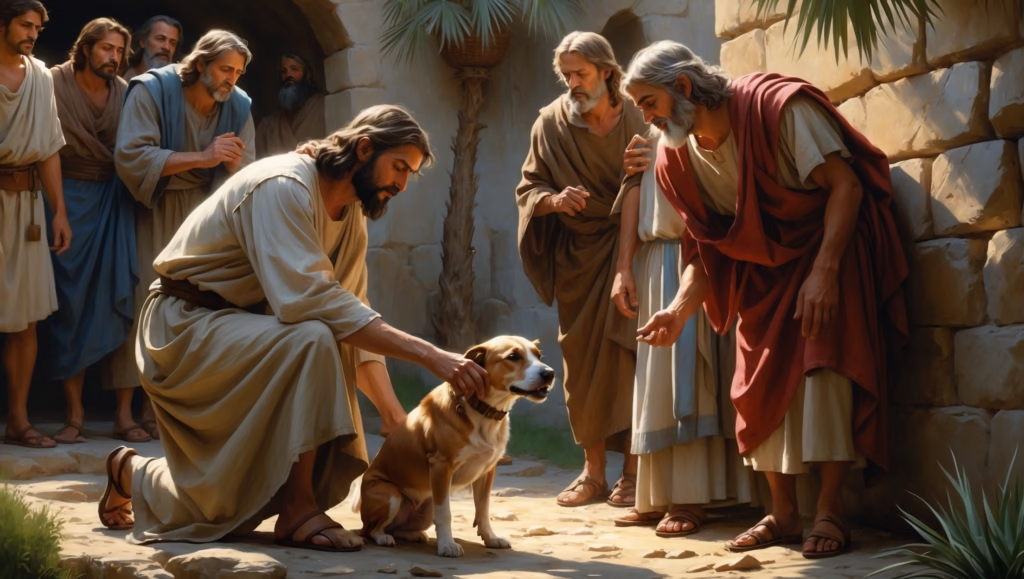Dogs as Cultural Symbols in First-Century Palestine
In Jesus’ time, dogs were far from the beloved companions we know today. Most were stray scavengers, roaming the streets, eating scraps, and often considered ritually unclean. In Jewish culture, calling someone a “dog” was a serious insult, loaded with moral and ethnic implications. Despite this, Jesus used dogs in His teachings and interactions, transforming a symbol of scorn into a vehicle for profound theological lessons.
Understanding these cultural perceptions helps illuminate the depth of His words. By invoking dogs, Jesus communicated faith, humility, compassion, and the radical inclusivity of God’s kingdom.

The Syrophoenician Woman (Mark 7:24–30): Faith Beyond Boundaries
One of the most well-known dog references occurs in the story of the Syrophoenician woman. When she approached Jesus to heal her demon-possessed daughter, He initially said, “It is not right to take the children’s bread and toss it to the dogs.”
At first glance, this seems harsh. Dogs were a derogatory symbol for Gentiles, implying exclusion. Yet the woman responded with humility and cleverness: “Yes, Lord, but even the dogs under the table eat the children’s crumbs.”
Her reply demonstrated remarkable faith and perseverance. Jesus commended her response and granted her request. Through this encounter, what began as a term of exclusion became an affirmation of God’s mercy extending beyond cultural and ethnic boundaries.
Do Not Give What Is Holy to Dogs (Matthew 7:6): Sacred Discernment
Another notable reference is found in the Sermon on the Mount, where Jesus warns, “Do not give what is holy to dogs; do not throw your pearls before pigs.” Here, dogs symbolize those unwilling or unprepared to receive spiritual truth.
The lesson is one of discernment. Just as a dog cannot appreciate consecrated food, some people are incapable of understanding or valuing God’s sacred gifts. This metaphor emphasizes wisdom, humility, and careful stewardship of spiritual truths.
Lazarus and the Dogs (Luke 16:19–31): Compassion from Unexpected Sources
In the parable of the rich man and Lazarus, Jesus describes Lazarus, covered in sores, lying at the gate of a wealthy man. “The dogs came and licked his sores,” He writes.
This detail is significant. While the rich man ignored Lazarus’ suffering, the dogs, despite their lowly status, showed care and compassion. The image underscores one of the parable’s central themes: God’s kingdom often reverses worldly hierarchies, valuing those whom society overlooks. The dogs, ironically, become agents of grace in a world otherwise marked by neglect.
From Scavengers to Companions: Transforming Cultural Perceptions
Although dogs were largely viewed negatively in Jesus’ world, their symbolic role evolved over time. In later Christian tradition, dogs were associated with loyalty, faithfulness, and protection. Saints were sometimes depicted with dogs, and the imagery shifted from unclean scavengers to exemplars of devotion.
This transformation mirrors a larger theological pattern: God often redeems what is despised or marginalized, turning symbols of shame into symbols of grace and faithfulness.
Modern Applications: Lessons from Jesus’ Canine References
The Gospels’ canine imagery carries timeless lessons:
- Faith Beyond Boundaries – The Syrophoenician woman’s story challenges us to approach God with humility and persistence, regardless of societal boundaries.
- Respect for the Sacred – Matthew 7:6 teaches discernment in sharing spiritual truths, ensuring the holy is not profaned.
- Compassion Over Indifference – The story of Lazarus reminds us to notice and care for those ignored by society, valuing acts of mercy even when they come from unexpected sources.
- Redemptive Transformation – Dogs’ evolving symbolism highlights how God redeems the marginalized, turning what is despised into instruments of grace.
Churches today even hold pet blessing ceremonies, a playful but meaningful continuation of Jesus’ use of animals as teaching tools. These practices show how His lessons transcend time, culture, and species.
Key Insight: Dogs as Theological Mirrors
When we read the Gospels with attention to Jesus’ use of animals, we see that His teachings engaged everyday life in culturally resonant ways. Dogs, once symbols of impurity, became mirrors of faith, humility, and compassion. Through seemingly ordinary images, Jesus challenged societal norms, revealed the radical inclusivity of God’s kingdom, and taught lessons that continue to resonate today.
By revisiting these passages, we understand that Jesus’ ministry was attentive not only to people but to the symbols embedded in their world—even the animals around them. Dogs, in His teachings, become more than animals; they become instruments of insight, reflection, and transformation.









